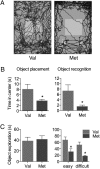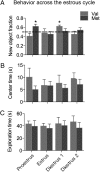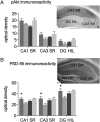BDNF variant Val66Met interacts with estrous cycle in the control of hippocampal function
- PMID: 20142488
- PMCID: PMC2840147
- DOI: 10.1073/pnas.0915105107
BDNF variant Val66Met interacts with estrous cycle in the control of hippocampal function
Abstract
Natural fluctuations in circulating estradiol are associated with behavioral changes, including severe disturbances in mood and cognition in some women. Common genetic variation in some of the molecular mediators of estradiol effects on these behaviors, in brain regions such as the hippocampus, may explain individual variation in estradiol effects on behavior. We tested whether the common human variant BDNF Val66Met interacts with estradiol in the control of hippocampal function in cycling female mice homozygous for the wild-type Val or BDNF Met variant. BDNF Met increased anxiety behavior, impaired memory, and increased expression of BDNF and its receptor TrkB in the hippocampal formation. BDNF Met also dramatically altered the fluctuation of spatial memory, hippocampal Akt phosphorylation, and PSD-95 protein expression across the estrous cycle. The variant BDNF Val66Met should therefore be considered as a strong candidate for mediating genetic differences in ovarian steroid-related behavioral changes and disorders.
Conflict of interest statement
The authors declare no conflict of interest.
Figures





Similar articles
-
Brain-Derived Neurotrophic Factor Val66Met Human Polymorphism Impairs the Beneficial Exercise-Induced Neurobiological Changes in Mice.Neuropsychopharmacology. 2016 Dec;41(13):3070-3079. doi: 10.1038/npp.2016.120. Epub 2016 Jul 8. Neuropsychopharmacology. 2016. PMID: 27388329 Free PMC article.
-
Brain-derived neurotrophic factor Val66Met genotype and ovarian steroids interactively modulate working memory-related hippocampal function in women: a multimodal neuroimaging study.Mol Psychiatry. 2018 Apr;23(4):1066-1075. doi: 10.1038/mp.2017.72. Epub 2017 Apr 18. Mol Psychiatry. 2018. PMID: 28416813 Free PMC article.
-
BDNF Val66Met impairs fluoxetine-induced enhancement of adult hippocampus plasticity.Neuropsychopharmacology. 2012 Apr;37(5):1297-304. doi: 10.1038/npp.2011.318. Epub 2012 Jan 4. Neuropsychopharmacology. 2012. PMID: 22218094 Free PMC article.
-
The aging hippocampus: interactions between exercise, depression, and BDNF.Neuroscientist. 2012 Feb;18(1):82-97. doi: 10.1177/1073858410397054. Epub 2011 Apr 29. Neuroscientist. 2012. PMID: 21531985 Free PMC article. Review.
-
BDNF variant linked to anxiety-related behaviors.Bioessays. 2007 Feb;29(2):116-9. doi: 10.1002/bies.20534. Bioessays. 2007. PMID: 17226799 Review.
Cited by
-
Differential involvement of brain-derived neurotrophic factor in reconsolidation and consolidation of conditioned taste aversion memory.PLoS One. 2012;7(11):e49942. doi: 10.1371/journal.pone.0049942. Epub 2012 Nov 21. PLoS One. 2012. PMID: 23185492 Free PMC article.
-
Exploring the Role of Neuroplasticity in Development, Aging, and Neurodegeneration.Brain Sci. 2023 Nov 21;13(12):1610. doi: 10.3390/brainsci13121610. Brain Sci. 2023. PMID: 38137058 Free PMC article. Review.
-
BDNF Val66Met Polymorphism: Suggested Genetic Involvement in Some Children with Learning Disorder.J Mol Neurosci. 2023 Jan;73(1):39-46. doi: 10.1007/s12031-022-02095-7. Epub 2022 Dec 23. J Mol Neurosci. 2023. PMID: 36550387 Free PMC article.
-
Variant brain-derived neurotrophic factor (Valine66Methionine) polymorphism contributes to developmental and estrous stage-specific expression of anxiety-like behavior in female mice.Biol Psychiatry. 2012 Sep 15;72(6):499-504. doi: 10.1016/j.biopsych.2012.03.032. Epub 2012 May 1. Biol Psychiatry. 2012. PMID: 22552045 Free PMC article.
-
Dicholine succinate, the neuronal insulin sensitizer, normalizes behavior, REM sleep, hippocampal pGSK3 beta and mRNAs of NMDA receptor subunits in mouse models of depression.Front Behav Neurosci. 2015 Feb 26;9:37. doi: 10.3389/fnbeh.2015.00037. eCollection 2015. Front Behav Neurosci. 2015. PMID: 25767439 Free PMC article.
References
-
- Protopopescu X, et al. Hippocampal structural changes across the menstrual cycle. Hippocampus. 2008;18:985–988. - PubMed
-
- Eberling JL, Wu C, Tong-Turnbeaugh R, Jagust WJ. Estrogen- and tamoxifen-associated effects on brain structure and function. Neuroimage. 2004;21:364–371. - PubMed
-
- Schmidt PJ, Nieman LK, Danaceau MA, Adams LF, Rubinow DR. Differential behavioral effects of gonadal steroids in women with and in those without premenstrual syndrome. N Engl J Med. 1998;338:209–216. - PubMed
-
- Sherwin BB. Estrogen and cognitive aging in women. Neuroscience. 2006;138:1021–1026. - PubMed
-
- Sherwin BB, Tulandi T. “Add-back” estrogen reverses cognitive deficits induced by a gonadotropin-releasing hormone agonist in women with leiomyomata uteri. J Clin Endocrinol Metab. 1996;81:2545–2549. - PubMed
Publication types
MeSH terms
Substances
Grants and funding
- NS07080/NS/NINDS NIH HHS/United States
- MH079513/MH/NIMH NIH HHS/United States
- R01 NS007080/NS/NINDS NIH HHS/United States
- P50 MH079513/MH/NIMH NIH HHS/United States
- R01 DA008259/DA/NIDA NIH HHS/United States
- P01 HL018974/HL/NHLBI NIH HHS/United States
- MH082528/MH/NIMH NIH HHS/United States
- R01 NS052819/NS/NINDS NIH HHS/United States
- F30 MH082528/MH/NIMH NIH HHS/United States
- NS052819/NS/NINDS NIH HHS/United States
- T32 GM007739/GM/NIGMS NIH HHS/United States
- DA08259/DA/NIDA NIH HHS/United States
- HL18974/HL/NHLBI NIH HHS/United States
LinkOut - more resources
Full Text Sources
Molecular Biology Databases
Miscellaneous

